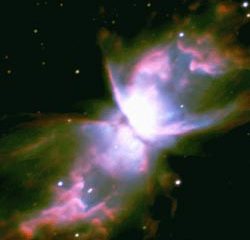An American engineer has produced a mathematical model explaining the elegant shape of the Eiffel Tower that was derived from French engineer Gustave Eiffel’s writings regarding his own fears about the effects of wind on such a structure.
University of Colorado at Boulder Associate Professor Patrick Weidman said Eiffel, one of the premier structural engineers in history, was determined to build the world’s first tower reaching 300 meters, the nearest metric equivalent to
A quiet revolution is coming our way. Recent successful trials of European semantic-Web applications suggest that machine-readable data will soon usher in an improved Web that will facilitate information reuse, and provide for painless building and maintenance of community portals.
“Computers struggle to attach meaning to information written in common Web languages such as Hypertext Markup Language [HTML],” says Libby Miller, coordinator of the IST SWAD-Europe project. “One way to h

For the first time, a team of astronomers based in Germany has detected the presence of magnetic fields in the central stars of four planetary nebulae. Planetary nebulae are expanding gas shells that remain after Sun-like stars eject their outer layers at the end of their lifetimes. It is a long-standing and unsolved mystery why 80% of all planetary nebulae are not spherical. Theories suggest that magnetic fields play a role in shaping planetary nebulae. The team, led by Stefan Jordan, has now
Cord blood cells limit heart attack damage in animal study
Stem cells from umbilical cord blood effectively treated heart attacks in an animal study, report cardiologist Robert J. Henning, MD, and colleagues at the University of South Florida and James A. Haley Veterans’ Hospital.
When injected into rats’ hearts soon after a heart attack, stem cells taken from human umbilical cord blood (HUCB) greatly reduced the size of heart damage and restored pumping func
The rice genome is larger, but we make the most of what we’ve got
In April 2003, scientists completed the massive Human Genome Project, recording for the first time in history the location and sequence of every gene in the human body. One result of the international project came as a bit of a shock. Scientists discovered that the body has only 30,000 genes, far fewer than the 50,000 to 140,000 they had expected to find.
Moreover, scientists learned that some less compl
SPACE DIGEST: JANUARY 2005
This release contains a summary of some significant astronomical and space events that will be taking place during January. It has been written in order to assist the media in planning and researching future stories related to space science and astronomy, particularly those with UK involvement. It is not intended to be fully comprehensive. Dates and times may be subject to change.
EINSTEIN YEAR
2005 is Einstein Year, the UK’s contribution to